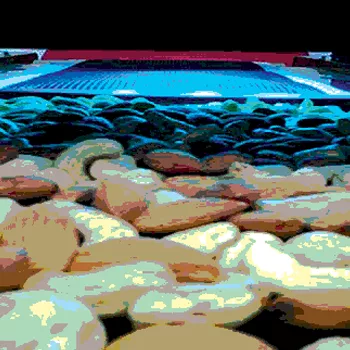UV Light-Emitting Diodes: The Upcoming Solution for Enhanced Food Safety

Ultraviolet (UV) light disinfection is a well-established technology for the treatment of air, water, and surfaces. In the last decade, UV technology has found more applications in the food production chain because it is an economic, effective, and versatile dry processing method that can potentially improve both food safety and the preservation of quality parameters. By definition, UV light is part of the electromagnetic radiation spectrum in the range from 180 to 400 nm that is further divided into UV-A, UV-B, and UV-C diapasons. In the UV-C or germicidal diapason between 180 and 280 nm, UV light can inactivate bacteria, viruses, cysts, mold, and yeasts. Photon absorption by microbial DNA at wavelengths from 240 to 280 nm induces DNA damage and sublethal damage to DNA repair systems.
The traditional way to generate UV-C light is using high-voltage, arc-discharge mercury or amalgam lamps that can generate photons solely at 253.7 nm. These quartz glass lamps with efficiencies of between 30 and 35 percent are broadly used for disinfection, but they are not food plant friendly because they require significant setup, maintenance, and control in this environment with a limited lifetime up to 18,000 hours. Light-emitting diodes or LEDs are semiconductor devices that can also emit UV-C light, but depending on the material properties of the diodes, they can emit photons at multiple wavelengths in the range between 255 and 365 nm. Visible (blue, green, and white) and infrared LEDs became commonplace in many electronics, curing, and lighting applications because of their extremely high efficiencies (up to 80%) and long lifetimes (around 100,000 hours). The germicidal effects of UV-C LEDs against bacteria, viruses, and fungi have already been demonstrated and reported, along with the first applications for disinfection of air, water, and surfaces made for “point of use” integration. Despite limited lifetimes and the fact that there are currently no commercial applications in food production, UV-C LEDs are the next wave in the LED revolution that can have numerous advantages for safety of food products and food plant facilities. Potentially, UV-C LEDs could be used for the treatment of beverages, disinfection of produce surfaces, packaging, and other food contact and noncontact surfaces. Some unique advantages of UV-C LEDs for food applications are discussed below.
Improved Inactivation Efficacy at Optimal UV-C Wavelengths
UV LEDs can be made to generate continuous light at the optimal germicidal wavelength tuned against specific microorganisms. Ongoing research at Agriculture and Agri-Food Canada (AAFC) evaluated the effectiveness of UV LEDs emitting between 259 and 370 nm against three common food pathogens: Escherichia coli O157:H7, Salmonella enterica, and Listeria monocytogenes.[1] UV-C LEDs emitting light in the approximate range of 259 to 265 nm were found to have the greatest efficacy in terms of bacterial inactivation but do not have good power output, with some strains of Salmonella remaining sensitive to wavelengths up to 289 nm. Also, it has been shown that tested organisms exhibited peak UV sensitivity at different wavelengths. Among the three pathogenic bacteria, S. enterica diarizonae and E. coli O157:H7 exhibited the highest overall UV sensitivities, which occurred at 259 nm. In contrast, L. monocytogenes peaked in UV sensitivity at 268 nm. The inactivation data between 253.7 and 370 nm were used to construct action spectra for the tested pathogenic and nonpathogenic strains. Figure 1[1] shows the UV action spectra of L. monocytogenes, E. coli O157:H7, and S. enterica diarizonae.
Therefore, the emitted wavelengths of UV LEDs in a food safety application can be adjusted for maximum efficacy against common food pathogens. In addition, UV-A LEDs at 365 nm and/or near UV wavelengths (405, 460, and 520 nm) were shown to reduce Salmonella on fruit; however, a significantly higher UV-A dose is typically required compared with the doses in the UV-C range.[2]
In some cases, germicidal efficacy can also be improved by combining different UV wavelengths to produce a synergistic effect and tuned to match the most effective inactivation in a given environment. For example, it has been shown that some strains of Listeria and E. coli are more sensitive to UV treatment at 259 and 289 nm applied simultaneously compared with either wavelength applied alone. This probably causes a hurdle effect due to the specific wavelengths damaging different cellular structures, compounding stress.
Shelf-Life Extension
UV-C LEDs can become a promising new UV source in the fresh produce industry due to the risks associated with food poisoning and by simultaneously extending produce storability and minimizing losses. For example, scientists at the U.S. Department of Agriculture tested UV LEDs in the range of 285 to 305 nm to extend the shelf lives of fresh fruits and vegetables in domestic refrigerators. A shelf life increase of two times was achieved using 20 mW/m2 of power output.[3] It has also been shown by Allende et al.[4] that UV LEDs can reduce natural microflora on lettuce leaves, thereby extending shelf life. In our current research, we have found that at the equivalent UV dose exposure, the 277 nm UV LEDs were at least as effective in reducing mold spores on the skin of apples as a low-pressure mercury (LPM) lamp at 253.7 nm.
Operating Advantages
Miniature, robust, and operating with low electrical power, UV LEDs can be manufactured with a highly stable output, operating at the optimum wavelength for the application. In addition, LEDs are mercury free, with no warm-up time and a potentially long lifetime that can make them ideal for a variety of processing solutions. Also, UV LEDs can be used in cold environments, as they have shown to increase power output as temperatures approach 0 °C, which further increases their versatility in terms of apparatus design. It has been shown that UV LEDs emitting at 268 nm can inactivate the psychrotolerant pathogen L. monocytogenes more effectively at refrigeration temperatures compared with room temperature due to the increased irradiance of UV LEDs at cold temperatures.[1] This is in contrast to LPMs, which decrease in power output as temperature decreases.
Potential High Efficiency and Energy Savings
To displace the incumbent mercury-based technology, UV-C LEDs require further development to improve device efficiency, lifetime, and cost. The biggest challenge with UV-C LEDs emitting at wavelengths shorter than 265 nm is that they are still weak light emitters. It is therefore important to consider the current trade-off between germicidal efficacy and power output (i.e., efficiency). Figure 2[1] shows the change in irradiance plotted against germicidal efficacy (in terms of log count reduction) of UV LEDs emitting at wavelengths between 259 and 365 nm against E. coli O157:H7.
The relationship between cost, power output, and inactivation efficacy of UV-C LEDs is an important consideration when selecting a UV treatment wavelength. UV LEDs also have a shorter lifetime—approximately 2,000 and 10,000 hours to reach 70 percent initial power output for UV-C LEDs emitting at 255 and 275 nm, respectively, compared with approximately 12,000–18,000 hours for an LPM lamp.
As UV-C LED efficiency improves at a lower cost of production and their lifetime increases, they will begin to replace existing UV-C lamps as a cost-effective, environmentally friendly alternative to save energy and improve safety and shelf life of produced foods from field to fork.
Flexibility of Applications for Experiments and Processing Solutions
Multiple-wavelength UV LED chips have great potential for use in benchtop-scale validation experiments. Their small size means they can be easily integrated into a collimated beam apparatus for the purpose of studying microbial inactivation kinetics at multiple wavelengths and wavelength optimization on surfaces and in liquid solutions. The UV LED collimated beam unit was used to select the optimal inactivation wavelengths against three food pathogenic organisms and find appropriate nonpathogenic surrogates. This unit consisted of an array containing three LEDs of each wavelength with thermal management, collimated tube, stand, and Petri dish, which allows testing in controlled conditions and measured UV exposure.
The selected LED chips can then be used in customized devices at higher irradiance to scale up disinfection processes by establishing the operating UV doses for specific product applications and intended technical effects. An example of a customized devices is a UV disinfection box that allows treating whole fresh produce samples. It also can be used for the purposes of the process validation and studies of the effects of product- and process-critical parameters.
UV-C LED chips enable flexible modular design over rigid lamps and their required bulky ballasts. UV-C LEDs can easily be incorporated into simple water filters, providing a highly effective solution for potable water needs that is easy to install and use with minimal supervision, maintenance, and space. Also, UV LED modules can be installed in areas where current UV lamps cannot be used, such as cold storage facilities, transport, and small disinfection apparatuses.
Upsizing from Bench-Scale to Industrial Disinfection Applications
Within the next decade or so, UV LEDs will quite likely fill many of the roles that LPM lamps currently fill in terms of UV-mediated safety solutions for liquids and surfaces. Modular devices use UV-A LEDs for industrial curing purposes. Replacing these chips with UV-C LEDs emitting a germicidal wavelength offers such devices potential for use in the disinfection of food products moving along a conveyor as well as the conveyor itself.
There is also the potential to integrate germicidal UV LEDs into industrial water and beverage disinfection. Currently, UV light is one of the most popular disinfection methods for municipal drinking water and wastewater. Replacing LPM lamps in these disinfection apparatuses with energy-efficient UV LEDs could result in significant energy savings for these municipalities while eliminating the risk of lamp breakage leading to mercury contamination of the water. UV LEDs could also be integrated into water-assisted disinfection of solid food, where the food (usually fresh or minimally processed produce) is submerged in water under constant agitation, and the entire rinse is exposed to UV light. UV LEDs could also be used in place of LPM lamps in certain devices that use UV light to disinfect produce submerged in water, agitated by air jets (Figure 5).

Current AAFC Research
At the AAFC, we are currently investigating the efficacy of 277 nm UV LEDs for the inactivation of the foodborne pathogens E. coli O157:H7 and L. monocytogenes, and mold spores on the surfaces of romaine lettuce and apples. Through the initial examination of the antimicrobial efficacy and power outputs of various wavelengths of UV LEDs, we have concluded that UV-C LEDs in the range of 275–280 nm have the current optimal trade-off between cost, lifetime, germicidal efficacy, and power output, as shown in Figure 2.
The 277 nm UV LEDs may also be more effective than LPM lamps emitting 253.7 nm light due to the greater penetration of longer UV wavelengths through both liquid and solid food matrices.
So far, it has been determined that 277 nm light from these UV LEDs can achieve the same maximum log reduction against L. monocytogenes on the surfaces of apples at a significantly smaller dose compared with the 253.7 nm light emitted from an LPM lamp. Therefore, it is worth investigating the efficacy of these UV LEDs as well as LEDs of similar wavelengths for potentially greater microbial inactivation and shelf-life extension.
Numerous studies have demonstrated the advantages of UV-C LEDs over LPM lamps. The data generated can be used to optimize UV treatment, improving inactivation efficacy and saving on treatment time and costs. No doubt, those UV LEDs present a new technological solution with potential for control of food pathogens and spoilage organisms throughout the supply chain from farm to fork. Further systematic engineering developments and approaches are necessary for industrial implementation.
Tatiana Koutchma, Ph.D., is a research scientist in novel food processing at the AAFC. She is graduate faculty at University of Guelph, Ontario, Canada, a member at large of the Nonthermal Processing Division of the Institute of Food Technologists, and Canadian Ambassador to the Global Harmonization Initiative.
Andrew Green, B.Sc., is working toward an M.Sc. degree at University of Guelph focusing on the use of novel methods and technologies for UV-mediated inactivation of foodborne pathogens on the surfaces of fresh and minimally processed produce.
Vladimir Popovic, M.Sc., joined the AAFC in 2014 and has been working in novel food processing technologies and coauthored several research manuscripts.
References
1. Green, A, et al. 2018. “Inactivation of Escherichia coli, Listeria, and Salmonella by Single and Multiple Wavelength Ultraviolet Light-Emitting Diodes.” Innovative Food Science & Emerging Technologies 47:353–361.
2. Kim, MJ, WS Bang, and HG Yuk. 2017. “405 ± 5 nm Light Emitting Diode Illumination Causes Photodynamic Inactivation of Salmonella spp. on Fresh-Cut Papaya without Deterioration.” Food Microbiol 62:124–132.
3. www.ledsmagazine.com/articles/2013/05/seti-and-the-usda-document-uv-leds-extending-shelf-life-of-fresh-produce.html.
4. Allende, A, et al. 2006. “Effectiveness of Two-Sided UV-C Treatments in Inhibiting Natural Microflora and Extending the Shelf-Life of Minimally Processed ‘Red Oak Leaf’ Lettuce. Food Microbiol 23(3):241–249.
Looking for quick answers on food safety topics?
Try Ask FSM, our new smart AI search tool.
Ask FSM →








